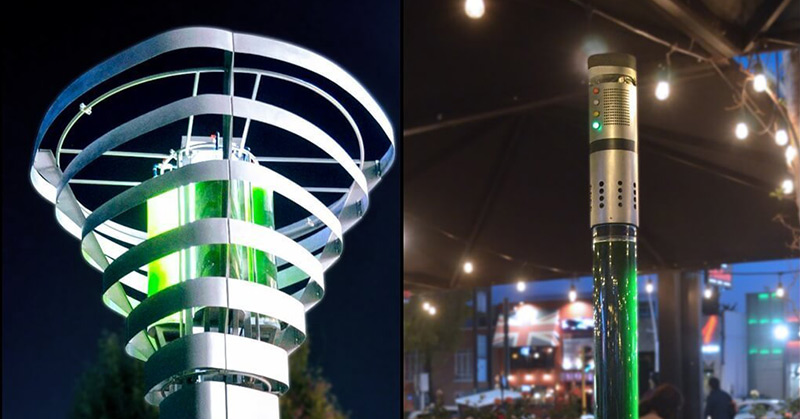Mexican company BiomiTech won the Innovation award at the Contamination Expo Series 2018 in Birmingham, England. Its entry, the BioUrban 2.0 system beat the other six finalists.
BiomiTech created an air purification system that transforms contaminants, such as carbon monoxide and nitrogen oxide, into oxygen. They accomplish this by using a species of microalgae who perform the natural process of photosynthesis. These microalgae developed by the company show a promising future for renewable energy.
“A single BioUrban is capable of carrying out the photosynthesis process and returning oxygen equivalent to [that released by] more than 300 trees,” says BiomiTech founding partner Jaime Ferrer.
“In the urban infrastructure where the pollution is—where all the cars circulate daily, in the intersections where the bus arrives and stops—are places where we can’t plant 300 trees but we can complete the same function through a natural biological process.”
The Design of BioUrban 2.0
BiomiTech’s purification system is four meters high and encased with steel. The top has a three-meter diameter and holds 500 liters of microalgae cultivation. That’s enough to filter about 99.7% of every particle it captures. One could picture the microalgae fulfilling the photosynthesis process by inhaling pollution and exhaling breathable oxygen. Overall, the system’s design resembles a tree.
There are also bonus features built into the system for user convenience. The device has a sensor to monitor air quality and is equipped with wireless internet abilities to transmit the data it receives. Waste microalgae can be used for biogas and biofuels. It is also self-sustaining through solar panels.
One BioUrban has the capacity to capture over 13 million cubic meters of polluted air, and release the amount of oxygen that 368 young eucalyptus trees release over one year. That is the equivalent of sustaining breath for 2,850 people per day.
“The most important cities in the world with significant pollution problems have highly-advanced sensors that measure contamination, but very few do something to control the problem,” says Ferrer. “This is the first technology, which through a 100 percent biological and natural process, enables contamination to be reduced.”
The Harmful Effects of Pollution
Most able-bodied people consider the air they breathe. However, poor air quality from pollutants like ground-level ozone, particle pollution, carbon monoxide, and sulfur dioxide can harm a person’s health. Those with lung and heart conditions are more suspectable to these negative effects:
- Irritations in the respiratory system
- Reduced lung function
- Inflammation in the cells lining the lungs
- Aggravated existing chronic lung diseases, like asthma, emphysema, and bronchitis
- Affect mental alertness and vision (only in the case of high levels of carbon monoxide)
People can learn about their city’s air quality index (AQI) through a website called AirNow that tracks it constantly. Alternatively, they can tune in to their local radio stations, TV, or newspapers that provide daily AQI reports as a part of the weather forecast. [1]
BioUrban’s Awards and Recognitions
In June, BiomiTech also won the Latin American Technological Innovation Award with the Latam Edge Awards in London for its environmentally safe technology. It beat 166 other firms from Latin America.
“It was very gratifying because they recognized Mexican talent abroad. The [Latam] prize consisted of 125,000 pounds (U.S. $162,450) in services, marketing, offices and advertising with the aim of starting operations in the United Kingdom,” comments Ferrer. The company takes pride that its technology is completely Mexican.
After having won the Contamination Expo Series and the Latam Edge Award, BiomiTech has achieved two prestigious recognitions within three months. This encourages the company to expand throughout Mexico after installing the first BioUrban system in Puebla in 2017.
“It makes me very proud to say that we’re being recognized at an international level but there’s still a lot to do in our country,” concludes Ferrer.
Reducing Pollution in Our Own Lives
Until BioUrban 2.0 becomes a part of every home, there are still ways to protect oneself from the detrimental effects of polluted air. These are recommendations from the U.S. Environmental Protection Agency (EPA):
- Conserve electricity by turning the thermostat a little lower in the winter and a little higher in the summer.
- Ensure the engines from cars and boats are properly tuned. Avoid engines that smoke.
- When possible, carpool, use public transportation, bike, or walk.
- Join a local energy conservation program.
- Plan out errands and combine them to reduce “cold starts” of the car and avoid long periods of idling with the engine on.
- Try using gas logs instead of wood. If one does have a wood-lit stove or fireplace, ensure it meets EPA design specifications, and burn only dry seasoned wood.
- Compost or mulch leaves and other yard wastes. [2]
- Ensure car tires are properly inflated.
- Whenever possible, use environmentally safe paints and cleaning products. [3]
- Air Quality Index – A Guide to Air Quality and Your Health https://www.airnow.gov/index.cfm?action=aqi_brochure.index
- Air Quality Guide for Particle Pollution https://www3.epa.gov/region1/airquality/pdfs/airqualityguideparticles.pdf
- Actions You Can Take to Reduce Air Pollution https://www3.epa.gov/region1/airquality/reducepollution.html

